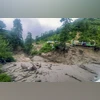)
A flash flood on July 31-August 1 killed at least eight workers of the Sumez project. | File photo: PTI
At least 14 hydroelectric projects in Himachal Pradesh have suffered damage due to flash floods since July 25, with some being affected multiple times over the past 10 years, according to a new analysis.
As damage to hydroelectric projects from flash floods and cloudbursts becomes a recurring issue — impacting both communities and power generation — experts are calling for disaster risk analyses to be conducted before such projects are undertaken.
They also recommend the preparation of robust disaster management plans, and the installation of early warning systems and flood forecast stations.
According to the analysis by the South Asia Network on Dams, Rivers, and People (SANDRP), two hydroelectric projects (HEPs) suffered significant damage due to a “cloudburst-induced flash flood” in the Palchan area of Kullu district on the intervening night of July 25-26.
Both HEPs — the 2-megawatt Pinnacle HEP on the Serai river and the 9-MW Beas Kund HEP on the Beas river — are owned and operated by private companies.
We have lost everything except the powerhouse building, Viany Parma, the manager of the Beas Kund project, told SANDRP.
Bhim Rawat of SANDRP said that Google Earth imagery shows that the powerhouses of both HEPs were built in active flood zones of the Serai and Beas rivers.
He said between July 29 and August 1, multiple flash floods damaged 12 HEPs in the Kullu and Shimla districts of the state.
Six projects were damaged in the Beas river basin in Kullu district, including the 4-megawatt Jirah HEP, 800-KW Raksat Mini HEP, 5-MW Brahmaganga HEP, 100-MW Malana 2 HEP, and 86-MW Malana 1 HEP.
The flash floods also impacted seven HEPs in the Ghanvi Khad and Samej Khad of the Sutlej river basin in the Rampur tehsil of Shimla district.
These are the 13.5-MW Upper Nanti HEP, 8-MW Kurmi HEP, 14-MW Lower Nanti HEP, 14-MW Sumez HEP, 22.5-MW Ghanvi 1 HEP, 4.5-MW Sechi HEP, and 10-MW Ghanvi II HEP.
A flash flood on July 31-August 1 killed at least eight workers of the Sumez project, according to media reports.
Some of the projects, including the Brahmaganga, Jirah, Beas Kund, Malana II, Upper Nanti, and Sumez HEPs, in both Kullu and Shimla districts have been affected multiple times over the past decade, the analysis showed.
Rawat said that the impact in Shimla is so severe that officials from private HEPs have been unable to reach the project sites to assess the damage.
The flash floods have rendered all 14 HEPs non-operational, leading to significant generation losses.
“The frequency of heatwaves and heavy rains is increasing due to global warming, and it’s only going to get worse. We should account for worsening extreme weather events when designing such projects,” Madhavan Rajeevan, former secretary of the Union Earth Sciences Ministry, told PTI.
Himanshu Thakkar, the coordinator of SANDRP, pointed out that there are no inflow forecast stations or level forecast stations in Himachal Pradesh. As a result, no flood forecasts are made in the state, which are crucial for saving lives and public property.
A Central Water Commission official in Shimla told PTI that there are plans to establish inflow and level forecast stations in the state but did not divulge details.
Thakkar added that the Union Environment Ministry should conduct disaster risk analyses before hydroelectric projects are built.
Independent post-disaster assessments should be conducted after such incidents. Robust disaster management plans should be prepared, and early warning systems should be installed, he said.
(Only the headline and picture of this report may have been reworked by the Business Standard staff; the rest of the content is auto-generated from a syndicated feed.)
First Published: Aug 22 2024 | 9:04 PM IST


































